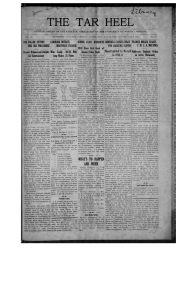
Harrison Moyle
The primary source I thought accurately depicted just how important food was during the Progressive Era, specifically in Chapel Hill was an article out of the Daily Tar Heel from 1916. This article describes the “First Feast of Season Friday Night” and allows some insight into the types of food served during this time at this university, as well as how much this university has changed its buildings since 1916 and how much smaller it was as a whole than today. It is very interesting to see how the food culture of this university has changed so much over 100 years.
The article describes how 48 members of the senior class sat down at Swain hall to eat foods such as grapefruit, creamed oysters on toast, drink maraschino, and smoke cigars and cigarettes. This was interesting because today the university would not allow smoking inside of any kind, nor would it serve alcohol to students. Also creamed oysters on toast sounds like a very fancy delicacy that would be too expensive to serve to the entire senior class of today. During this feast, the article also mentions how all the men should be familiar with “business terms and methods.” This can reflect on the Progressive Era at the time and how America was at a time of prosperity, especially with the big industry businesses. It is also interesting how Swain Hall is no longer a dining hall, but rather a building for offices today, reflecting on how small the senior class was again. Since this article was called the “First Feast of Season Friday Night,” it is possible that these types of feast occurred on a more frequent occasion with formalities such as having a toastmaster and having certain people and professors have specific seats at the tables to display their importance. This is show when the article mentions, “Roy Homewood, whose natural position is end, found himself, with the squab on toast, illogically near the center of the program.” The article also mentions how cigars and cigarettes were associated with “informal talks,” and it seems that the professors would be called upon to discuss the subjects they were teaching. Overall, this article was very interesting in the food choices that they served back then, it seemed like toast was prevalent at these feasts with several types of spreads. It is also interesting to see the culture change of how food was eaten compared to eating in a dining hall such as Lenoir today compared to these feasts they would prepare with professors, senior students, and other important figures of the university at this time.